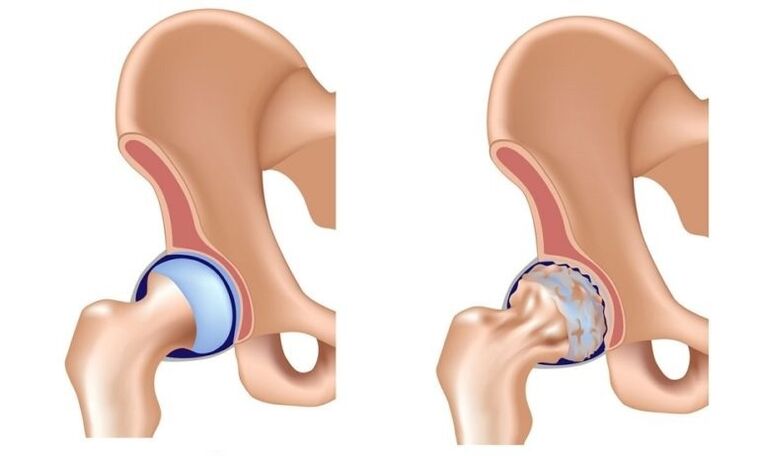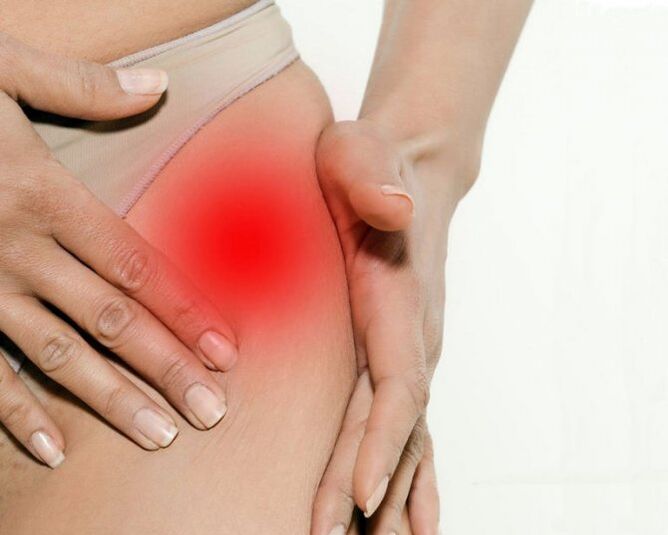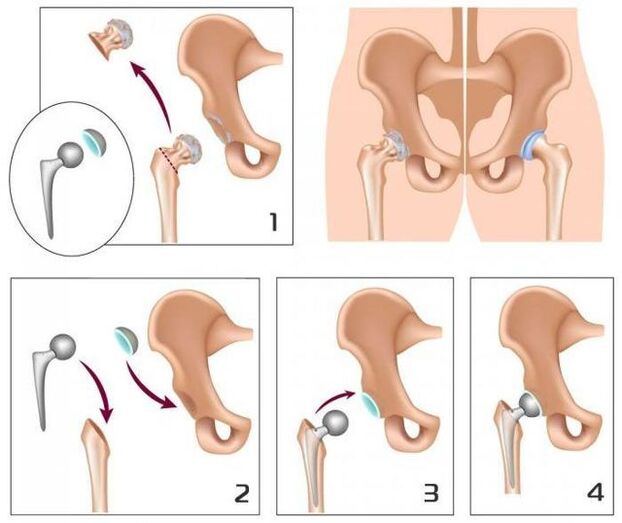
The joints of the hip joint (deformed arthritis, COXARTHROSIS, joints) are a slow-degenerative disease-degenerative disease, leading to the time to destroy the affected joints, persistent pain and mobile restrictions.
The disease affects people over the age of 40, women are sick more often than men.
In the overall structure of arthritis, the joint disease of the hip belongs to the leading role.This is due to the widespread congenital disease of the hip joints (dysplasia), as well as significant physical efforts, which these joints are easily.
Risk factors and causes of joint disease of the hip joint
In the pathological mechanism of the development of joint disease of the hip joint, the main role belongs to the change in the physical and chemical characteristics of the activated liquid (internal joint), because it becomes more dense and viscous.This worsens her lubricant.When moving, the cartilage surfaces began to rub with each other, becoming rough, covered with cracks.The small particles of Hyalin cartilage were abandoned and fell into the joint, causing the development of aseptic (no infection) in it.As the disease progresses into the process of inflammation, bone tissue is drawn into the inflammatory process, leading to aseptic necrosis of the parts of the femur and the surface of acetabulum, the formation of bone cells (bone growth), enhancing inflammation and causing serious pain.
Within the end of the joints of the hip joint, inflammation is also thrown into the surrounding joints of tissue (blood vessels, nerves, ligaments, muscles), leading to the appearance of signs of endocarditis.As a result, the hip joint is completely destroyed, its functions are lost, moving in it ends.This condition is called ankyl disease.
Causes of hip joint disease:
- congenital lips of the thigh;
- hip dysplasia;
- Aseptic necrosis of the femur;
- Peters;
- injury of hip joints;
- Infectious arthritis of hip joints;
- Gonarthrosis (osteoarthritis of the knee joint);
- Osteochondrosis;
- Excess weight;
- professional sports;
- Flat feet;
- The curvature of the spine;
- A sedentary lifestyle.
The disease is not inherited, but the child inherits the characteristics of the structure of the skeletal muscle system from parents, which can cause joint disease of the hip joint in this condition.This explains the reality of the existence of families, the incidence is higher in the general population.
Diseases
Depending on the cause, the joint disease of the hip is divided into the main and secondary.Secondary arthritis develops based on other diseases of hip joints or its injury.The main form is not related to the previous pathology, the reason for its development is often impossible, in this case they talk about idiopathic arthritis.
Coksartrosis is one or bilateral.
Stage
Three stages (degrees) are distinguished during the joints of the hip joint:
- The initial pathological changes are shown a bit, provided that the timely and adequate treatment is reversed.
- Coxarthrosis progresses - characterized by gradually increasing symptoms (joint pain and weakening its ability to exercise), changes in joint tissues that have been inverted, but therapy can slow down the degeneration process.
- The final movement in the joint is lost, ankylis disease is formed.Treatment can only surgery (replacing joints with artificial).
Endoprosthetic activity in 95% of cases ensure complete recovery of expenditure, restoration of patient performance.

Symptoms of hip arthritis
The main signs of arthritis of hip joints:
- Pain in groin, hips and knees;
- A stiff feeling in the joints is affected and its mobility limit;
- disturbance;
- restricting abduction;
- Change the muscle atrophy of the thigh.
The presence of some joint symptoms of the hip joint, as well as their severity depends on the degree of disease.
At level 1 of the hip arthritis, the patient complains about the pain in the affected joints under the effects of physical activity (prolonged walking, running).In some cases, the pain is located in the area of the knee or thigh.After a short rest, the pain passed by himself.The mass of the spending movements is fully preserved, the gait is not broken.The following changes are recorded on X -ray:
- mitigate unevenly in the heart of the general gap;
- Osteophytes lies on the inner edge of the rotation.
Any changes from the neck and femur are not detected.
With the level of arthritis II of the hip joint, the pain also appears when resting, including at night.After physical activity, the patient began to limp, a typical gait of the duck was formed.Therefore, the pain began to appear - after a long time of motionless, the first few steps caused pain and discomfort, then passed and then returned after a long load.In the affected joint, the mass of motion (abduction, inner rotation) is limited.X -ray shows that the uneven joint distance is narrowed and its heart is 50% of the norm.Osteophytes are placed both along the inner and outer edges of the joint, beyond the boundary of the cartilage.The borders of the femur are uneven due to deformation.
With level III of arthritis of hip joints, intense and constant, not stop at night.Walking is a significant difficulty, the patient is forced to rely on the stick.The mass of movement in the affected joint is limited, then it completely stops.Due to the atrophy of the hip muscles, the pelvic bone is deviated in the front plane and the limb is shortened.Trying to compensate for this shortening, the patient when walking is forced to refuse the body towards the injury, which increases the load on the pain.On X -ray, bone growth, significantly narrowing the joint distance and significant increase in the thigh bone is detected.
Diagnose
Diagnosis of hip joint disease is based on the data of the clinical picture of the disease, the results of medical examination and the research of tools, in which the main value belongs to the visual method - X -ray, magnetic resonance images or calculations.They not only allow the presence of hip joint disease and assess their extent, but also determine the possible cause of the disease (trauma, youthful biological analysis, Peters).
Diagnosis of the joints of the hip from other diseases of the musculoskeletal system is quite complex.At the level of arthritis II and III of the hip joint, muscle atrophy develops, can cause positive pain in the knee characteristics of the drive or Gonarthrosis (knee joint disease).To distinguish these states, the touch of the knee and hip joints is felt, the mass of the movement in them is determined, and they are also tested by X -ray.
In the diseases of the spine, in some cases, the nerve roots of the spinal cord with the development of painful pain syndrome.Pain may radiate the area of the hip joint and imitate the clinical picture of its failure.However, the nature of pain with X -ray syndrome is slightly different from the joints of the hip joint:
- The pain occurs is the result of lifting weights or difficult movements, and is not influenced by physical efforts;
- The pain is located in Gluteal, not an inguinal area.
With piercing syndrome, patients may calmly take their feet to the side, while having joints of the hip joint, the kidnapping is limited.A typical sign of piercing syndrome is a positive symptom of stress - the appearance of a strong pain when trying to lift a straight leg on the patient's back.
The hip arthrosis affects people over the age of 40, women who are sick are many times more often than men.
Arthrosis of hip joints should also be distinguished from loyal burst (trochanter).Burs inflammation may grow faster, within a few weeks.Usually he is gone before effort or significant injury.In this disease, the pain is much more obvious than the joints of the hip joint.At the same time, shortening the limbs and its mobility limit is not detected.
The clinical painting of non -typical reaction arthritis and joint spondylitis may be similar to the clinical manifestations of arthritis of the hip.However, the pain occurs in the patient mainly at night or when resting, when walking does not strengthen, but on the contrary, on the contrary, weakening.In the morning, the patient noted the hardness in the joints, passing after a few hours.
Joint treatment of hip joints
Orthhopedians is involved in the treatment of the hip joint.With the level I and II of the disease, conservative therapy is specified.With obvious pain syndrome, patients are prescribed anti -inflammatory drugs without prescribed in a short course.They should not be accepted for a long time, as they can not only have a negative impact on the organs of the digestive tract, but also prevent the reconstruction of hyalin cartilage.
In the treatment regimen of hip joint disease, they include chondroprotector and vasodilators, creating optimal opportunities to restore damaged cartilage tissue.With a clear muscle spasm, it may require the appointment of central muscle relaxants.
In cases when it is impossible to prevent pain syndrome with non -caught anti -inflammatory drugs, use in intracellular corticosteroid injection.
Local treatment of hip muscle disease by using heat ointment allows you to reduce muscle spasms and slightly weakened due to distraction.
In the complicated therapy of hip arthritis, physiotherapy methods are also used:
- Magnetic therapy;
- Thermal freedom;
- Uhf;
- laser therapy;
- ultrasound treatment;
- massage;
- Medical equipment;
- Craft therapy.

Nutrition diet for joints of the hip joint in order to adjust body weight and normalize metabolic processes.Reducing body weight reduces the load on the hip joints and thus slows the progression of the disease.
To unload the affected joints, the doctor may recommend the patient to crutches or sugarcane.
With the level III of the joint disease of the hip joint, conservation treatment is ineffective.In this case, the patient's condition can be improved, which can return normal motor ability only due to surgical intervention - replacement of artificially destroyed by artificial (endrosthetic).
Consequences and complications may occur
The most serious complication of the progressive arthritis of the hip joint is the defect due to the loss of motion in the joint.With Coksartrosis on both sides, patients lose their ability to move independently and need continuous foreign care.For a long time in a bed in a position that creates a prerequisite for the appearance of pneumonia (hypostatic), is very difficult and can lead to death.
The pathology is not inherited, but the child inherits the characteristics of the structure of the musculoskeletal system from parents, which can cause joint disease of the hip.
Forecast
The joint disease of the hip is a progressive chronic disease, can only be completely cured in the early stages, eliminated the cause of the disease.In other cases, the therapy allows you to slow down its process, however, over time, the hip -hip implant is required.Such activities in 95% of cases provide fully recovering the ability to move and restore the patient's performance.The service life of modern fake parts is 15-20 years, then they have to replace.
Prevent
The prevention of hip arthritis aims to eliminate causes that can lead to the development of this disease, and include:
- Timely detection and treatment of hip diseases and injuries;
- Refusing a sedentary, regular lifestyle, but not too physically active;
- Control body weight;
- Reasonable nutrition;
- Refuse bad habits.



























